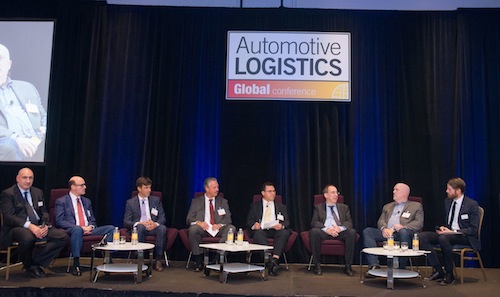The automotive logistics industry is well known for being evolutionary rather than revolutionary. Change doesn’t happen overnight and this is not likely to change any time soon. However, technology is moving fast and although adoption throughout the supply chain has been slow so far, OEMs and LSPs are confident that more technology and utilisation of big data will be seen. At the close of Automotive Logistics Global 2015 in Detroit, executives gathered to discuss OEM/LSP relationships, how technology will affect their businesses and what the upcoming challenges and opportunities will be.
The panel featured (second left to right): Bradley Jacobs, chairman and CEO, XPO Logistics; Ed Feitzinger, chief executive, UTi; Dana McBrien, associate chief advisor, Honda of America; Miguel Tavera, director, global logistics purchasing, General Motors; Matthias Schulz, director, North America material planning and logistics, Ford; and Marc Brazeau, head, NAFTA vehicle transportation, Chrysler.

How the connected car could change the supply chain
 Brazeau, Chrysler: I’m not sure the connected car will have a huge impact on the supply chain model. I am, however, amazed at the application of technology – I’ve driven for 20 years and it’s something I’ve never considered before. As a driver there are a lot of things that will change, but for the supply chain, I think it will be the same things that we’re doing in the near future.
Brazeau, Chrysler: I’m not sure the connected car will have a huge impact on the supply chain model. I am, however, amazed at the application of technology – I’ve driven for 20 years and it’s something I’ve never considered before. As a driver there are a lot of things that will change, but for the supply chain, I think it will be the same things that we’re doing in the near future.
 Schulz, Ford: For me the customer market will change significantly, with things such as autonomous driving. However, if you go back in time, and it’s probably true for most of us, nothing has really changed for 10-15 years. So can we keep pace with what’s happening around us?
Schulz, Ford: For me the customer market will change significantly, with things such as autonomous driving. However, if you go back in time, and it’s probably true for most of us, nothing has really changed for 10-15 years. So can we keep pace with what’s happening around us?
 Tavera, GM: There are two elements here: we have to make sure we deliver vehicles at the right time, and the consumer base will become a lot more selective and change a lot more. Buying will change too. In the future cars will not be bought through dealers, but online, so how will this change the supply chain? It will change but not to a huge extent.
Tavera, GM: There are two elements here: we have to make sure we deliver vehicles at the right time, and the consumer base will become a lot more selective and change a lot more. Buying will change too. In the future cars will not be bought through dealers, but online, so how will this change the supply chain? It will change but not to a huge extent.
 McBrien, Honda: We should be talking about the connected consumer. Flexibility will become key, and keeping up will be the real challenge.
McBrien, Honda: We should be talking about the connected consumer. Flexibility will become key, and keeping up will be the real challenge.
 Feitzinger, UTi: It’s about how disruptive things will be. The supply chain in automotive is fixed, but we need to talk about flexibility, that is what changes. We need to create a more responsive supply chain.
Feitzinger, UTi: It’s about how disruptive things will be. The supply chain in automotive is fixed, but we need to talk about flexibility, that is what changes. We need to create a more responsive supply chain.
 Jacobs, XPO: I’m interested in what Google is doing. I’m not quite sure what it is they are doing, it could be a threat. In terms of connectivity, we all agree that autonomous vehicles are coming. It could be a very interesting opportunity and a big market.
Jacobs, XPO: I’m interested in what Google is doing. I’m not quite sure what it is they are doing, it could be a threat. In terms of connectivity, we all agree that autonomous vehicles are coming. It could be a very interesting opportunity and a big market.
 Brazeau, Chrysler: Regardless of all the connectivity, cars still need to be delivered. We’ve heard a lot about Amazon, and I would argue that is being done on the parts and materials side already. However, how we build vehicles, assemble them, connect suppliers to plants and integrated logistics centres, and deliver products in a specific window based on our expectations, that’s where there will be challenges.
Brazeau, Chrysler: Regardless of all the connectivity, cars still need to be delivered. We’ve heard a lot about Amazon, and I would argue that is being done on the parts and materials side already. However, how we build vehicles, assemble them, connect suppliers to plants and integrated logistics centres, and deliver products in a specific window based on our expectations, that’s where there will be challenges.
How complexity affects the supply chain
 Brazeau, Chrysler: I’m not sure the complexity in choice drives complexity in operations on the FVL side.
Brazeau, Chrysler: I’m not sure the complexity in choice drives complexity in operations on the FVL side.
 McBrien, Honda: From a supply chain perspective, a lot of what we’re doing is building flexibility. When someone says there will be a ‘huge change’, you want to be able to say ‘ok’. We have to build flexibility into solutions, capacity and in our approach and ability to re-engineer the networks.
McBrien, Honda: From a supply chain perspective, a lot of what we’re doing is building flexibility. When someone says there will be a ‘huge change’, you want to be able to say ‘ok’. We have to build flexibility into solutions, capacity and in our approach and ability to re-engineer the networks.
 Schulz, Ford: We need to be more flexible, but it has to work together with manufacturing: built-to-order in 24 hours – that simply can’t happen. We can’t get a car out of China and ship it to Canada in a day, and we have to customise at the latest moment possible. A company like Tesla, for example, can be disruptive because they have no history.
Schulz, Ford: We need to be more flexible, but it has to work together with manufacturing: built-to-order in 24 hours – that simply can’t happen. We can’t get a car out of China and ship it to Canada in a day, and we have to customise at the latest moment possible. A company like Tesla, for example, can be disruptive because they have no history.
 Tavera, GM: Change isn’t a new thing in the automotive industry. We’ve gone through change and disruption over the years. We do need to have a flexible supply chain to cope with these changes. I had a conversation with some of our suppliers, who were not born and raised in automotive, and they tend to believe there are a lot of good things and practices from other industries that we can adapt.
Tavera, GM: Change isn’t a new thing in the automotive industry. We’ve gone through change and disruption over the years. We do need to have a flexible supply chain to cope with these changes. I had a conversation with some of our suppliers, who were not born and raised in automotive, and they tend to believe there are a lot of good things and practices from other industries that we can adapt.
How LSPs can develop (from their own perspective)
 Feitzinger, UTi: Sometimes we forget the advantage of being in the US or Europe. If you’re in India you just want a truck that goes from A to B, and if you’re a Chinese OEM trying to penetrate east Africa you just want to be able to successfully cross a border. We’re trying to grow first world transport in places where customers are trying to expand, but where we’re looking for millions, some are looking for pennies. In many cases the infrastructure doesn’t work. We want to do well in emerging markets but we need to take emerged market solutions in emerging markets and leave the drones until afterwards.
Feitzinger, UTi: Sometimes we forget the advantage of being in the US or Europe. If you’re in India you just want a truck that goes from A to B, and if you’re a Chinese OEM trying to penetrate east Africa you just want to be able to successfully cross a border. We’re trying to grow first world transport in places where customers are trying to expand, but where we’re looking for millions, some are looking for pennies. In many cases the infrastructure doesn’t work. We want to do well in emerging markets but we need to take emerged market solutions in emerging markets and leave the drones until afterwards.
 Jacobs, XPO: We want to take inefficiencies out of the supply chain and dedicate the money to R&D – doing projects in IT, and being connected to customers and asking what they want. Customers want speed, transparency, track and trace, and for the cheapest price possible.
Jacobs, XPO: We want to take inefficiencies out of the supply chain and dedicate the money to R&D – doing projects in IT, and being connected to customers and asking what they want. Customers want speed, transparency, track and trace, and for the cheapest price possible.
How LSPs can develop (from an OEM perspective)
 Tavera, GM: Purchasing is a different function that GM is trying to do in logistics right now. I don’t think life is easier on the carmaker side. When you’re an LSP you say you wish you could be on that side, but it’s not that easy. For shippers in general, I think the most important thing is to listen to your customer. Sometimes they’re eager to say what their capabilities are, but that may or may not be useful. LSPs need to be aggressively proactive on a number of things – focus on operations, bring innovation, check operations are running correctly, bring innovative ideas… once that happens it’s up to us.
Tavera, GM: Purchasing is a different function that GM is trying to do in logistics right now. I don’t think life is easier on the carmaker side. When you’re an LSP you say you wish you could be on that side, but it’s not that easy. For shippers in general, I think the most important thing is to listen to your customer. Sometimes they’re eager to say what their capabilities are, but that may or may not be useful. LSPs need to be aggressively proactive on a number of things – focus on operations, bring innovation, check operations are running correctly, bring innovative ideas… once that happens it’s up to us.
I would encourage all LSPs to continue to be hungry all the time: you go in, make a sale, it’s a gruesome and complicated process; you’re with the customer for two to five years; you’re not that hungry; then it’s no longer valid.
 Schulz, Ford: Find a guy whose name is Uber and get him to work for you. Disruption will not only happen in automotive, it’s happened in other industries too. Take some risks: there will be failures but I’m pretty confident it will be successful.
Schulz, Ford: Find a guy whose name is Uber and get him to work for you. Disruption will not only happen in automotive, it’s happened in other industries too. Take some risks: there will be failures but I’m pretty confident it will be successful.
 McBrien, Honda: Get the customer to listen to you, that’s really important. LSPs don’t necessarily embrace change… the business is different for every customer, and we need to listen to LSPs when they come to us too.
McBrien, Honda: Get the customer to listen to you, that’s really important. LSPs don’t necessarily embrace change… the business is different for every customer, and we need to listen to LSPs when they come to us too.
 Brazeau, Chrysler: We’re finally at the point of promise of improving transparency and visibility. We’ve spent the last 30 years using API and connecting through the supply base. Now we need to use that data visibility and the richness of data – big data – to get waste out of the system.
Brazeau, Chrysler: We’re finally at the point of promise of improving transparency and visibility. We’ve spent the last 30 years using API and connecting through the supply base. Now we need to use that data visibility and the richness of data – big data – to get waste out of the system.
How OEMs can help LSPs to help OEMs
 Jacobs, XPO: I’ve never seen a reality where it’s an equal partnership where a customer is as interested in what we’re purchasing. At the end of the day OEMs talk about service and want service, but it comes down to price. You have to take cost out of the system. I’ve almost given up trying to get customers to listen to me.
Jacobs, XPO: I’ve never seen a reality where it’s an equal partnership where a customer is as interested in what we’re purchasing. At the end of the day OEMs talk about service and want service, but it comes down to price. You have to take cost out of the system. I’ve almost given up trying to get customers to listen to me.
 Feitzinger, UTi: Procurement is the enemy of collaboration. To evaluate a bid fairly or ethically, you have to have an apples-to-apples comparison, but that doesn’t allow LSPs to offer different services in order to save money. You would have to go back and open that up to everyone again... there needs to be an open opportunity for innovation – positive disruption. That would give OEMs and LSPs the opportunity to help each other.
Feitzinger, UTi: Procurement is the enemy of collaboration. To evaluate a bid fairly or ethically, you have to have an apples-to-apples comparison, but that doesn’t allow LSPs to offer different services in order to save money. You would have to go back and open that up to everyone again... there needs to be an open opportunity for innovation – positive disruption. That would give OEMs and LSPs the opportunity to help each other.
How LSPs can get new ideas through to OEMs
 Brazeau, Chrysler: Disruption costs millions of dollars. We tend to maintain deliverable quality and stay in those parameters until we get to an organic evolution. It’s an expensive proposition to make significant change. We’re not without change – some things we’ve done together have set the benchmark on global supply chains. There is innovation but there is an issue around cost, and sourcing is an issue. OEMs have high fixed costs and it’s difficult on the LSP side. They work extremely well as an industry pulling together solutions.
Brazeau, Chrysler: Disruption costs millions of dollars. We tend to maintain deliverable quality and stay in those parameters until we get to an organic evolution. It’s an expensive proposition to make significant change. We’re not without change – some things we’ve done together have set the benchmark on global supply chains. There is innovation but there is an issue around cost, and sourcing is an issue. OEMs have high fixed costs and it’s difficult on the LSP side. They work extremely well as an industry pulling together solutions.
At the end of the day, every OEM has sourced something that may have had a high reward, but you don’t want to be six months into a programme that’s meant to last years and it’s failing and you have to start again.
In the past 20 years there has been evolution, but certainly not a bloody revolution. We will continue to evolve, it’s in everyone’s DNA.
When we talk about LSPs the challenge is that they need to see continuous improvement as part of the DNA of the industry. It’s hard to gain traction if you don’t bring it to the table.
 Tavera, GM: A year ago we had a large conference and invited a number of providers. One of the topics we brought to the table was that help is here. We also talked about how you can profit while we reduce costs. Talking about it helps. It is possible, but it’s not easy. We have to work as OEMs to set the stage and make it happen. Suppliers here said as OEMs, we tend to tell logistics suppliers what we want to do. LSPs have to try to understand the capabilities behind the curtain when they’re working with us.
Tavera, GM: A year ago we had a large conference and invited a number of providers. One of the topics we brought to the table was that help is here. We also talked about how you can profit while we reduce costs. Talking about it helps. It is possible, but it’s not easy. We have to work as OEMs to set the stage and make it happen. Suppliers here said as OEMs, we tend to tell logistics suppliers what we want to do. LSPs have to try to understand the capabilities behind the curtain when they’re working with us.
How consolidation of LSPs affects business for OEMs
 Schulz, Ford: Obviously we need to work with people of a certain size: we produce millions of cars and work with lots of people. You need a certain size to be in the automotive industry, but people that are more creative tend to be smaller. You have to find the right balance. If a company gets too big, it can stop evolution. There’s a certain size, but it shouldn’t grow beyond a certain level.
Schulz, Ford: Obviously we need to work with people of a certain size: we produce millions of cars and work with lots of people. You need a certain size to be in the automotive industry, but people that are more creative tend to be smaller. You have to find the right balance. If a company gets too big, it can stop evolution. There’s a certain size, but it shouldn’t grow beyond a certain level.
I’m a strong believer that you can outsource a lot of things. Clearly you need to stay in control of what’s happening, but you’re not making money by being efficient in logistics, it’s by selling cars. It’s difficult for super logistics providers to understand that sometimes. They would never be on the inner train of the next generation of products. That drives a lot of our decisions around logistics, and that needs to be done by OEMs themselves.
 Brazeau, Chrysler: It’s about the right hammer for the right nail. You need scale and scope but the bottom line is execution and cost. It comes down to where you need scale – globally or inter-regionally, and whether your LSPs can execute at the right cost and quality.
Brazeau, Chrysler: It’s about the right hammer for the right nail. You need scale and scope but the bottom line is execution and cost. It comes down to where you need scale – globally or inter-regionally, and whether your LSPs can execute at the right cost and quality.
 McBrien, Honda: Big and integrated across regions and services can be important. It’s good to blend services that are complementary of each other.
McBrien, Honda: Big and integrated across regions and services can be important. It’s good to blend services that are complementary of each other.
 Tavera, GM: A large company can help you to leverage scale, and go into markets and tailor specific solutions. If that company isn’t helping you however, and won’t move because of the management system then that’s not a good company to work with in terms of scale. It’s about balance.
Tavera, GM: A large company can help you to leverage scale, and go into markets and tailor specific solutions. If that company isn’t helping you however, and won’t move because of the management system then that’s not a good company to work with in terms of scale. It’s about balance.
How size matters for LSPs
 Feitzinger, UTi: On the forward side, it’s critical mass that you need and we think we’re there. However, 3PL warehousing and trucking is a local business. If you’re trying as an OEM you have to go country-by-country. You need to understand the market you’re working in – even in the US it varies by state.
Feitzinger, UTi: On the forward side, it’s critical mass that you need and we think we’re there. However, 3PL warehousing and trucking is a local business. If you’re trying as an OEM you have to go country-by-country. You need to understand the market you’re working in – even in the US it varies by state.
 Jacobs, XPO: I think it’s partly because we have leadership positions in some areas such as premium freight and technology, that we get the business. The fact that we’re the second biggest does make a difference – we have 7,700 trucks and that distinguishes us. Having the capability is the ticket of admission.
Jacobs, XPO: I think it’s partly because we have leadership positions in some areas such as premium freight and technology, that we get the business. The fact that we’re the second biggest does make a difference – we have 7,700 trucks and that distinguishes us. Having the capability is the ticket of admission.
I have a huge amount of respect for purchasing departments: their job is to try to squeeze us and give the illusion of another option even when there isn’t one. They’re good at that. Maybe they are telling the truth and all costs have gone up… I’m in awe of purchasing departments…
How OEMs will cope with upcoming challenges
 Tavera, GM: The ability to adapt to supply chain logistics is key. A lot of my role is to develop every single region. We have challenges in the US and in growth markets. A focus on talent will be important from our perspective.
Tavera, GM: The ability to adapt to supply chain logistics is key. A lot of my role is to develop every single region. We have challenges in the US and in growth markets. A focus on talent will be important from our perspective.
 McBrien, Honda: Managing talent will be important as our current management team ages. We have to continue to develop for the next generation, whether that’s today or moving into procurement. We need to continue to be change agents in our organisations.
McBrien, Honda: Managing talent will be important as our current management team ages. We have to continue to develop for the next generation, whether that’s today or moving into procurement. We need to continue to be change agents in our organisations.
 Brazeau, Chrysler: There’s the promise of visibility and transparency, as well as cost in the network. All of us invest in certain things in a silo. We need to have the ability to analyse big data really quickly, and be able to communicate more effectively, and share more effectively. On the outbound side we should be considering competitive advantage and how we drive cost. I hope that in five years from now we’re talking about success stories and getting rid of invoicing and accounts: they shouldn’t be a barrier to productivity.
Brazeau, Chrysler: There’s the promise of visibility and transparency, as well as cost in the network. All of us invest in certain things in a silo. We need to have the ability to analyse big data really quickly, and be able to communicate more effectively, and share more effectively. On the outbound side we should be considering competitive advantage and how we drive cost. I hope that in five years from now we’re talking about success stories and getting rid of invoicing and accounts: they shouldn’t be a barrier to productivity.

























![Global[1]](https://d3n5uof8vony13.cloudfront.net/Pictures/web/a/d/s/global1_726550.svgz)









